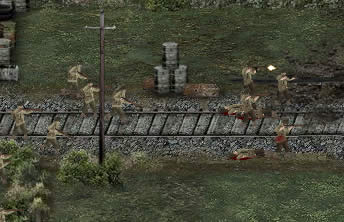Trench Warfare Game 1944

World War I: Battle of Verdun Overview of the Battle of Verdun, 1916. Contunico © ZDF Enterprises GmbH, Mainz A trench system may begin simply as a collection of foxholes hastily dug by troops using their entrenching tools. These holes may subsequently be deepened so that a soldier can safely in one of them, and the individual foxholes may be connected by shallow crawl trenches.
3 basic elements of tactical HF radio security; New Barrett Communications USA Office. 2050 HF Transceiver brochure. Your free white paper on Barrett 4050 HF. The Barrett manpack uses a Barrett 2050 deployed in the Barrett 2040 manpack adaptor, therefore all the operations described in the manual above will operate when the 2050 transceiver is in this configuration. HF Radio Communications BARRETT MADE IN AUSTRALIA BCB205001/15 www.barrettcommunications.com.au 2050 HF SSB Transceiver 2050 Secure long range voice, email, telephone, and tracking Rapid mobile or base station installation Reliable and easy to operate Independent of all other communications networks Free to air - no call costs. Hf radio aircraft.
From this beginning a system of more permanent may be constructed. In making a trench, soil from the excavation is used to create raised parapets running both in front of and behind the trench. Within the trench are firing positions along a raised forward step called a fire step, and duckboards are placed on the often muddy bottom of the trench to provide secure footing. The ancestor of modern trench warfare was the system of progressively extended trenches developed by the French military engineer for the attack of fortresses in the 17th century. Trenches remained merely a part of siegecraft until the increasing firepower of and compelled both sides to make use of trenches in the (1861–65). The trench lines of the in the final months of that war were the foremost example of trench warfare in the 19th century. Fort Mahone, Petersburg, Virginia Breastworks of the Confederate Fort Mahone (“Fort Damnation”), Petersburg, Virginia, April, 1865.
Jun 30, 2009 - Warfare 1944, a free online Strategy game brought to you by Armor Games. Rising out of the trenches and onto the battlefield of Normandy,.
Library of Congress, Washington, D.C. (LC-B8171-3211 DLC) Trench warfare reached its highest development on the during (1914–18), when armies of millions of men faced each other in a line of trenches extending from the Belgian coast through northeastern to. These trenches arose within the first few months of the war’s outbreak, after the great offensives launched by and France had shattered against the deadly, withering fire of the and the rapid-firing piece. The sheer quantity of bullets and shells flying through the air in the battle conditions of that war compelled soldiers to burrow into the soil to obtain shelter and survive. Trench warfare A German machine gun emplacement during World War I.

Prints and Photographs Division/Library of Congress, Washington, D.C. (digital file no. LC-USZ62-136100) The first, or front, line of trenches was known as the outpost line and was thinly held by scattered machine gunners distributed behind dense entanglements of. The main line of resistance was a parallel series of two, three, or four lines of trenches containing the bulk of the defending troops. The defenders’ artillery was posted to the rear of the main line of trenches.
Pour charger un logiciel GPS300, on me demande d'installer ser2pl.sys'de USB_serial cable diskette ou trouver ce fichier Merci. Download ser2pl.sys: Click here to run a free scan for ser2pl.sys related errors How to Install ser2pl.sys Repair Sys ProblemsFixing a corrupted or missing ser2pl.sys. Usb to serial ser2plsys downloads.
Each main line of trenches was fronted by fields of barbed wire intended to slow down and entangle attacking. As World War I progressed, both sides, but particularly the Germans, developed trench systems of progressively greater depth and strength in order to ensure that the enemy could not achieve a breakthrough at any particular point. The Germans evolved an extremely elaborate defense system using pillboxes, i.e., concrete shelters for machine guns. Behind the pillboxes were more lines of barbed wire and more trenches and dugouts reinforced with concrete to withstand artillery bombardment. Behind these defenses were still more lines of trenches that were effectively out of range of the enemy’s artillery fire. By 1918 the Germans had constructed some trench systems that had a depth of 14 miles (22 km).
Throughout most of World War I, the opposing armies on the Western Front tried to break through the enemy’s trench system by mounting infantry assaults preceded by intense artillery bombardments of the defending trenches. These attacks usually failed, partly because the preliminary bombardment alerted the defenders to the imminence of an attack, thus allowing them time to bring up reserves for a counterattack, and because the bombardments themselves turned the “no-man’s-land” between the opposing sides into rough, shell-pocked terrain that slowed down the attacking infantry. The crucial elements in attacking a trench system, surprise and overwhelming numbers of infantry, were thus almost impossible to attain. The Allies’ increased use of the in 1918 marked the beginning of the end of trench warfare, however, since the tank was invulnerable to the machine gun and fire that were the trenches’ ultimate defense. British Mark I tank with anti-bomb roof and “tail,” 1916.